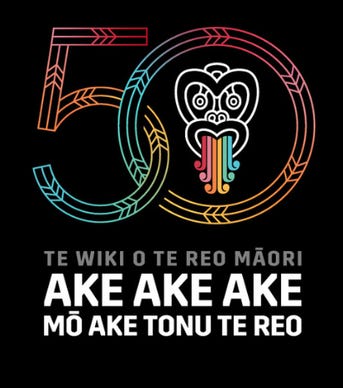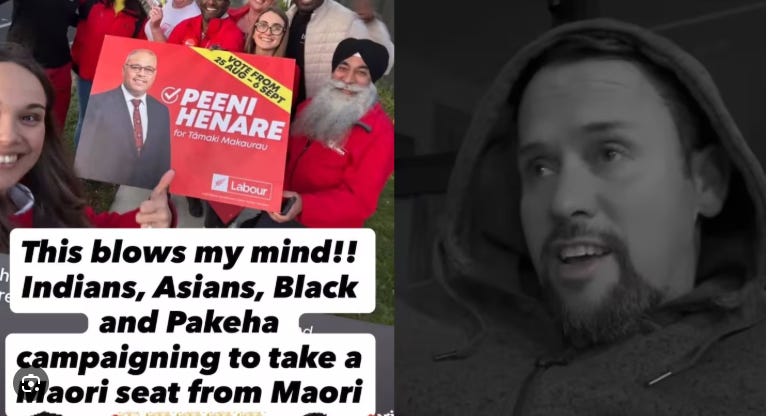The 50th Rainbow-tongued Māori Language Week is over.

I was in Morocco that week, so missed the opportunity to contribute to the associated State-sponsored Te Reo Time Capsule (to be opened in 50 years’ time), or to take up any of the “50 reo-based challenges”.
The indigenous people of Morocco are the Berbers, also known as the Amazigh. In 2011, Morocco recognised the Amazigh language as an official language. Since then, Morocco has taken other measures to officially recognise other aspects of Amazigh culture.
The Moroccan Parliament reserves 60 seats for women and 40 seats for people under 30 years of age. But there are no seats reserved for the Amazigh. Quite rightly recognizing that race-based political parties are a recipe for societal division, sectarianism and civil strife, the Moroccan constitution expressly bans ethnicity-based political parties. So there can be no Amazigh equivalent of the Māori Party.

The Māori Party’s Oriini Kaipara won the 2025 Tāmaki Makaurau by-election, held on 6 September following the untimely death of Māori Party MP Takutai Tarsh Kemp in June 2025. Kaipara secured 6,948 votes, defeating Labour’s Peeni Henare, who received less than half the votes that Kaipara received. The total vote count in the by-election was 10,688.

Radio New Zealand reported Kaipara’s victory as yet more evidence of a burgeoning Radical Māori Renaissance, quoting Māori Party co-leader Debbie Ngarewa-Packer as saying that “Tāmaki Makaurau voted for unapologetic representation”. But in truth, the Tāmaki Makaurau result shows there’s a upper limit on the extent to which the Maori Party’s narcissistic racism will find support from New Zealanders with Māori ancestry.

About 208,000 Māori live in the Tamaki Makaurau electorate. Of them, about 44,000 (21%) have registered on the Tamaki Makaurau Māori electoral roll. But only 10,688 (about a quarter of those 44,000) voted in the Tāmaki Makaurau by-election, and only about two-thirds of them voted for Oriini Kaipara. So in sum, only 3.3% of Māori in the Tamaki Makaurau electorate voted for Kaipara, the successful candidate.
As opposed to evidencing a burgeoning Radical Māori Renaissance, the Tāmaki Makaurau by-election result demonstrates, beyond a shadow of a doubt, that the Māori Party’s race prism appeals to only a very small minority of Māori. And the result demonstrates another important thing…that urban Māori rightly recognise that John Tamihere, President of the Māori Party and Suzerain of his Waipareira Trust urban Māori Mafiosi, couldn’t care less about ordinary Māori.
Tamihere is more concerned about defending Māori Party MP Tākuta “Feral” Ferris’ claim that only people with Māori ancestry should have been allowed to support Peeni Henare’s failed bid for the Tāmaki Makaurau seat.

In the 2023 general election, the Māori Party won six of the seven Māori electorate seats. Under New Zealand’s Mixed Member Proportional (MMP) electoral system (without the Māori electorates), the Māori Party’s share of the party vote (3.25%) would only have entitled the Māori Party to four seats. To preserve overall MMP proportionality, this “overhang” increased the size of Parliament from 120 to 122 MPs, for the current electoral term.
Based on the Tamaki Makaurau electorate result, it seems virtually certain that the Māori Party will sweep all seven Māori electorate seats at the 2026 election (assuming the current Government doesn’t collapse earlier).
If the Māori Party does indeed win all the Māori electorates, and the Māori Party’s share of the party vote remains about the same as in the 2023 election (3.25%), then that would result in a three seat “overhang” and 123 (three additional) seats in Parliament. All of which would increase the likelihood of a Labour/Greens/ Māori Party Coalition Government.
The latest (September) Radio New Zealand-Reid Research political poll is interesting. According to that poll, if a general election were held now, an otherwise deadlocked Parliament (Right & Left blocks with 60 seats each) would, as a result of a one-seat “overhang” from the Māori Party winning its current six Māori electorate seats, deliver Labour/Greens/Māori a one seat majority, enabling them to form a Government.
Let’s canvass another couple of scenarios…
- Based on the Radio New Zealand-Reid Research political poll, and assuming that the Māori electorates have been abolished (which could be achieved by a simple Parliamentary majority) and that the Māori Party achieves 5% of the party vote, the Right Block would be able to form a Government – with 62 seats over the Left Block’s 58 seats.
- Based on that same political poll, and assuming that the Māori electorates have been abolished and that the Māori Party does not achieve the 5% of the party vote required to be represented in Parliament, the Right Block would be able to comfortably form a Government – with 64 seats over 56 seats for the depleted Left Block (Labour/Greens).

On 21 September, Heather du Plessis-Allan expressed her opinion in The Herald that the Māori Party has no prospect of being in the next Government, because Labour would never go into coalition with the Māori Party. In Heather’s opinion, Labour stands a better chance of getting back into power if it states categorically that in no circumstances will it go into coalition with the Māori Party.
Heather du P-A is obviously entitled to her opinion. But that’s where it ends for Heather’s Herald opinion piece. The chances of Labour and the Greens alone forming the next Government are, for all practical purposes, nil.
And to think that Labour would not, on principle, go into government with the Māori Party because of that party’s racist rantings misses the point. Labour has no principles except the pursuit of power. This is a “Labour” party that has abandoned its traditional constituency of common working people and small businesses in favour of New Zealand’s mushrooming legions of welfare beneficiaries and the LGBTQIA+ brigade. Groucho Marx could have been Chris Hipkins when he quipped “These are my principles. If you don’t like them, I have others”.

Labour MP Willie Jackson rarely communicates clearly enough for anyone to be able work out whether what he says is correct. But in an interview on 24 September, available on Stuff, Jackson was right on the Māori money when he claimed that the Labour and Māori Parties are “90%” aligned. So, despite Hipkins’ and Jackson’s criticisms of Ferris’ claim that only Māori should have been allowed to support Labour’s Henare, on “matters Māori” Labour and the Māori Party are joined at the hip.
The battle lines are therefore drawn. The next general will be a flat out foot race between the incumbent coalition Government and a unified, well-organized Left Block comprising the Labour, Greens & Māori political parties. Labour’s economic sabotage may well work in its favour, leaving the electorate so desperate for even more Government hand-outs that it elects a Left Block coalition – helped over the line by the Māori seats. Even if radical Māori separatism has peaked, it may still be palatable enough to successfully deliver New Zealand to Hell in a Handbasket.

John McLean is a citizen typist and enthusiastic amateur who blogs at John's Substack where this article was sourced.


6 comments:
You sound kinda upset, John. Democracy will help, you get to cast a vote for the people you think will do the best job. Kia kaha!
What a silly suggestion that Maori radicalism may have peaked.
It will have peaked once there is total tribal rule and those not in the top group are treated no better than slaves. Until then it will just be more of the same. A tribal elite growing ever fatter, as they stomp on their own people to prove they are victims.
TPM understand the overhang theory. They also understand that infiltrating the unions will deliver gold for them. For "unions" substitute "NZ Labour Party". Together thay all have one goal in mind. Beware NZ.
You say a virtual landslide is guaranteed to the incumbent government if the Māori seats were abolished.
Why then, has this not been pursued?
Answer, the National party have no intention of closing down the Māorification process it has dedicated itself to.
If either of the two main parties are in control after the next election, we can all expect to see the process continue as intended.
Simple solution, abolish Maori seats...boom, gone!
The low maori turnout for the bye election simply illustrated the maori te ao of not exerting a mite more effort than absolutely necessary to retain some perk. With its outlandish statements so appealing to basic maori it would have been generally realised within the insurgency coordination network that TPM would romp in. So why exert to vote, especially if no feed or other bribes now on offer. The majority of maori can now convert to the main roll and vote Labour, secure in the knowledge that a manic self serving fringe will occupy the maori seats. The Labour billboard advert was very strange. With support from others implied, on the principle that anything which suits others must be at maori expense it seemed designed to discourage self centred maori from voting Labour.
Post a Comment